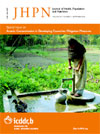
|
The Journal of Health, Population and Nutrition
icddr,b
ISSN: 1606-0997
EISSN: 1606-0997
Vol. 22, No. 4, 2004, pp. 383-398
|
 Bioline Code: hn04047
Bioline Code: hn04047
Full paper language: English
Document type: Research Article
Document available free of charge
|
|
|
The Journal of Health, Population and Nutrition, Vol. 22, No. 4, 2004, pp. 383-398
| en |
Triaging Patients with Post-abortion Complications: A Prospective Study in Nepal
Thapa, Shyam; Poudel, Jaya & Padhye, Saraswati
Abstract
The first manual vacuum aspiration (MVA) services unit in Nepal was established in 1995 at the country's
largest national maternity hospital in Kathmandu. This research sought to assess and evaluate the
safety, acceptability, and effectiveness of MVAservices. This prospective study was conducted during 12
months in 1998, and follow-up was made at six weeks. Two groups of patients were compared: 529
patients treated in the MVA unit and 236 patients who were clinically eligible for treatment in the MVA
unit but were treated instead in the main operation theatre (OT) owing to the unavailability of services in
the MVA unit during the hours of their admission. The two groups differed with respect to some of their
background characteristics but were similar in their clinical characteristics. The MVA group received
contraceptive counselling and services and had significantly shorter stays in hospital. However, the direct
cost incurred by the patients, regardless of the type of facility they used, was about the same. Follow-up
at six weeks revealed that the MVA patients had significantly fewer complaints and were generally more
satisfied with the services they had received than their counterparts. Slightly more than half of the women
in the MVA group were using contraception at the time of follow-up compared to no women in the OT
group. It is concluded that the MVA unit provided safe, effective, and efficient services to about 50% of
all the patients admitted to the hospital with post-abortion complications. An additional 25% of the postabortion
patients could be served if the unit were kept open 24 hours a day, saving resources and time for
patients and hospital staff. As a parallel development, both MVAand main OT services would need to be
more effectively integrated with outside antenatal and family-planning clinics to address the reproductive
health needs of women, thereby reducing the number of patients requiring post-abortion care.
Keywords
Manual vacuum aspiration; Abortion; Counselling; Contraception; Healthcare; Prospective studies; Nepal
|
| |
© Copyright 2004 - The Journal of Health, Population and Nutrition
Alternative site location: http://www.jhpn.net
|
|
